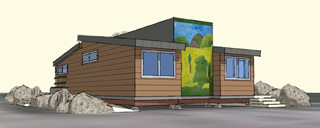|
Subscribe / Renew |
|
|
Contact Us |
|
| ► Subscribe to our Free Weekly Newsletter | |
| home | Welcome, sign in or click here to subscribe. | login |
Environment
| |
December 10, 2012
Local team Sprout! designing net-zero modular classrooms
Journal Staff Reporter
Stacy H. Smedley, Ric Cochrane and James Jenkins were moved when they heard some kids from Canada talk at a recent sustainability conference about how they wanted to get a living building in their district.
“They've got nature all around them, but they are seeing the environment being harmed in other places,” Smedley said.
So the trio — who work in architecture and construction in Seattle — decided to do something about that.
In May, during the Living Future UnConference in Portland, they founded The Sprout! Collective with the goal of bringing sustainable learning spaces to children worldwide.
Sprout designed a net-zero modular classroom called Seed, which will create all the energy and water it needs. It will serve three schools in Jasper in western Alberta, Canada, where the kids from the conference attend school. The classroom incorporates some ideas they got from the youngsters when they visited there.
Sprout has applied for nonprofit status and is seeking donations and grants so that its partner, Seattle-based Method Commercial (a subsidiary of Method Homes), can built the classroom to meet the standards of the Living Building Challenge, Smedley said. Sprout intends to donate the classroom to the school district.
Quantum Consulting Engineers is the structural engineer for the Jasper project, which will serve kindergarten through 12th grade students in Grande Yellowhead Public School Division No. 77 starting with the 2013-14 school year.
The 960-square-foot classroom is made of three modules that can be shipped. The core module houses all the components that make the classroom self-sustaining. Two side modules add a lab space and entry vestibule.
The classroom will have a composting toilet, solar panels, skylights, lots of windows, a living wall, toxin-free materials, super-insulated envelope, roof water collection system, highly efficient mechanical equipment and a system to treat potable water.
It will be a living laboratory for students and a way for Sprout to demonstrate the effectiveness of net-zero design and construction, Smedley said.
Sustainability curriculum called Seed Packets that Sprout also developed will come with it.
Students will monitor the energy and water they use in the classroom — and energy the classroom produces — and will be encouraged to find ways to cut back. For instance, they will use hand pumps to get water at a lab sink. Water will collect in a clear container over the sink so students can see how much water they need to wash their hands.
Gray water from all the classroom sinks will be filtered and treated by a living wall that grows food.
When Seed classrooms are added in other places they will be connected virtually to create an online learning community.
Sprout estimates it will cost between $220,000 and $250,000 to design and build the classroom, Smedley said, and it has raised about 10 percent of that. The goal is to have the structure completed so it can be displayed at the 2013 Living Future UnConference in Seattle next May.
“Our thought process is to start small and to think big,” Smedley said.
She said Sprout wants eventually to sell Seed classrooms and curriculum to other schools, and use any profits above administrative costs to donate Seeds to schools that can't afford them.
She said two private schools and one public school in the Seattle area have approached Sprout for information about Seed.
Smedley is an associate at KMD Architects in Seattle, Cochrane is project manager for the Preservation Green Lab, and Jenkins is sustainability manager at BNBuilders in Seattle.
They were part of the Bertschi School Living Science Building project that opened two years ago in Seattle.
“We've watched these kids using it and they're doing amazing things,” Smedley said.
Students monitor energy use and test the quality of water that collects in a cistern at the building, which was constructed to meet the Living Building Challenge.
“We're watching their minds shift so that it is normal to them,” Smedley said. “If we could have that same environment (for) kids all over the world, what impact is that going to have on them as adults?”
The Sprout! Collective's website is www.thesproutcollective.org.
Lynn Porter can be
reached by email or by phone
at (206) 622-8272.



